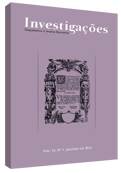José de Alencar: por uma historicidade em mão dupla
Abstract
O artigo identifica o espaço romanesco como o elemento de mediação entre o fato e a ficção no romance histórico de José de Alencar, aproximando, desta maneira, o pensamento historiográfico da representação literária.References
ALENCAR, José de. 1965. A polêmica Alencar-Nabuco. In: COUTINHO, Afrânio (org). A polêmica Alencar-Nabuco. Rio de Janeiro: Tempo Brasileiro.
______. 1953. Nota referente à 1ª edição. In: ______. Guerra dos mascates. Crônica dos tempos coloniais. 2a ed. Rio de Janeiro: José Olympio. V. XIV.
______. 1981. O Rio de Janeiro – prólogo. In: FREIXIEIRO, Fábio. Alencar: os bastidores e a posteridade. 2a ed. Rio de Janeiro: Museu Histórico Nacional, p. 109-14.
CASCUDO, Luís da Câmara. 1955. O folclore na obra de José de Alencar. In: ALENCAR, José de. Til. Romance brasileiro. 3a ed. Rio de Janeiro: José Olympio, p. 3-10. V. XI.
COLLINGWOOD, R. G. 1986. A ideia de história. Trad. de Alberto Freire. 6ª ed. Lisboa: Editorial Presença.
CROCE, Benedetto. 1974. História e crônica. In: GARDINER, Patrick. Teorias da história. Trad. de Vítor Matos e Sá. Lisboa: Fundação Calouste Gulbenkian, p. 275-83.
FOGEL, R. W.; ELTON, G. R. 1989. ¿Cuál de los caminos al pasado? Dos visiones de la historia. Cidade do México: Fondo de Cultura Económica.
GARDINER, Patrick. 1971. Teorias da história. Trad. de Vítor Matos e Sá. Lisboa: Fundação Calouste Gulbenkian.
LACAPRA. Dominick. 1983. Rethinking intellectual history: texts, contexts, language. New York: Ithaca.
RICOEUR, Paul. 1997. Tempo e narrativa. Trad. de Roberto Leal Ferreira. Campinas: Papirus. III t., t. III.
Downloads
Published
How to Cite
Issue
Section
License
Copyright (c) 2011 Marcelo Peloggio

This work is licensed under a Creative Commons Attribution 4.0 International License.
Authors who publish with Revista Investigações agree to the following terms:
Authors retain copyright and grant the journal right of first publication with the work simultaneously licensed under the Creative Commons Attribution 4.0 International (CC BY 4.0) license that allows others to share the work with an acknowledgement of the work's authorship and initial publication in this journal.
Authors are able to enter into separate, additional contractual arrangements for the non-exclusive distribution of the journal's published version of the work (e.g., post it to an institutional repository or publish it in a book), with an acknowledgement of its initial publication in this journal.
You are free to:
Share — copy and redistribute the material in any medium or format for any purpose, even commercially.
Adapt — remix, transform, and build upon the material for any purpose, even commercially.
The licensor cannot revoke these freedoms as long as you follow the license terms.
Under the following terms:
Attribution — You must give appropriate credit , provide a link to the license, and indicate if changes were made . You may do so in any reasonable manner, but not in any way that suggests the licensor endorses you or your use.
No additional restrictions — You may not apply legal terms or technological measures that legally restrict others from doing anything the license permits.

